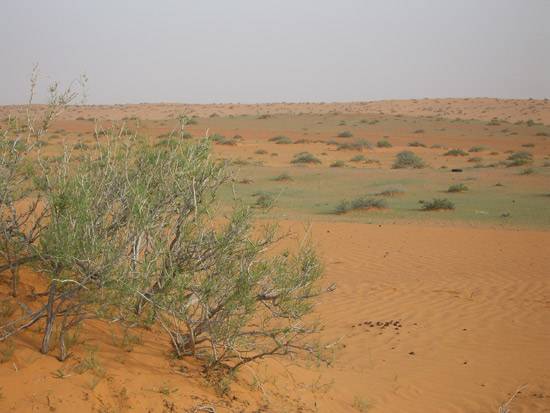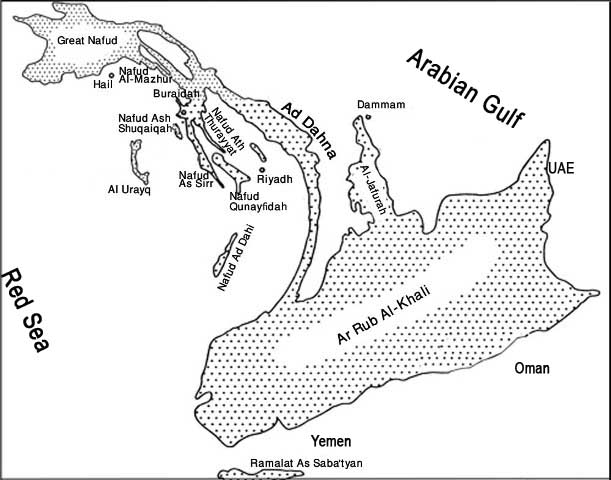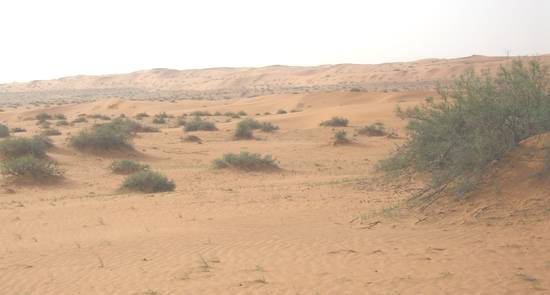
30% of the land in Saudi Arabia is covered by sandy-deserts. Although the desert of Saudi Arabia is more or less continuous, extending from North to South, the Nafud in the north and the Rub-al-Khali in the south are the largest among all. Other sand bodies, such as the crescent-shaped Dahna situated in the Najd Area and the Al-Jafurah on the Eastern region are relatively smaller in size. Rub-al-Khali occupies an area of about 650,000 sq. km with sparse vegetation. Sand dunes in this desert often reach a height of about 250 m, especially on the eastern side of the country. Rainfall is almost nil in this desert. Yet sporadic rains measuring about 35 mm/year are reported in some years. Vegetation composed of diffuse shrubs. Annual plants are virtually nil in this desert. Rub-al-Khali or the 'Empty Quarter' is believed to be the largest continuous sand body in the world and supports the life of at least a few endemic plants such as Calligonum crinitum spp. arabicum, Tribulus macropterus var. arabicus (Tribulus arabicus), Cornulaca arabica, etc.
The Great Nafud is composed of transverse sand dunes that often reach up to a height of about 120 m. The sand of Nafud is reddish in colour due to iron oxide coating while the sands of other deserts are somewhat yellowish in colour. The sandy deserts of the central Saudi Arabia consist of an arch-shaped Dahna in the east and a number of smaller sand bodies such as Nafud Al Mazhur, Nafud ath Thuwayrat, Nafud as Sirr, Nadud Qunayfidhah, Nadud ash Shuqayyiqah, Al Urayq, Irq Subay, etc. The sands in these bodies contains high sand ridges with flat interdune beds with shallow, stable sand.
Life in the desert, particularly plants, insects, lizards, rodents, snakes, birds, etc. are highly dependent and each one helps in the survival of the others. As the rains in the deserts are intermittent and erratic, every drop of water that fall on the sand is precious for the existence of plants and animals. Plants have several adaptations that help them to survive in the desert, such as ability to collect and store water, features that help reduce water loss, etc.
Desert plants usually have small leaves or leaf-like appendages, thick, waxy cuticle on the surface of stems and leaves, sunken stomata, sand covered strong-roots that help to penetrate deep into the soil in search of water and also help the plant to hold firmly on the ground against sand-storms. As far as the animals are concerned, the source of water comes from the plants, while in the case of carnivorous creatures /animals the water need is satisfied by the fluids contained in the bodies of the animals that they live upon.
Vegetation of Rub Al-Khali is dominated by three widespread communities, viz. 1. Cornulaca arabica community, 2. Calligonum crinitum- Dipterygium glaucum community and 3. Haloxylon persicum community. Great Nafud and Dahna sands are dominated by Calligonum comosum-Artemisia monosperma-Scrophularia hypercifolia community and Haloxylon persicum-Artemisia monosperma-Stipagrostis drarii community whereas the Jafurah desert is dominated by Calligonum comosum-Cyperus conglomeratus community in the interios and along the borders by Haloxylon salicornicum-Zygophyllum mandavillei or Panicum turgidum communities supported by associated species such as Centropodia fragilis, Dipterygium glaucum, Moltkiopsis ciliata, Stipagrostis drarii, etc.

